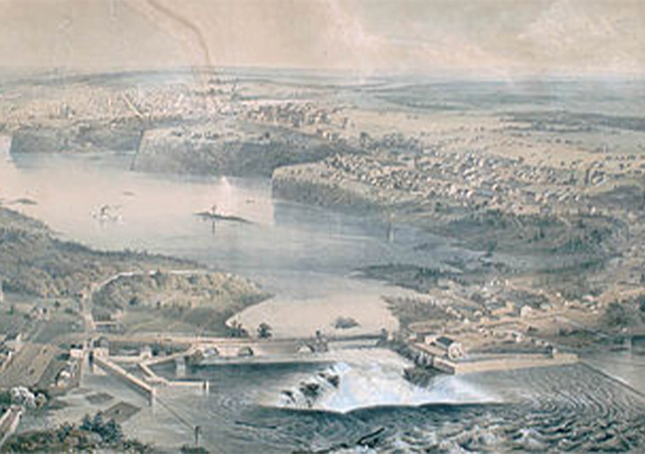Ottawa

Ottawa (/ˈɒtəwə/ (About this soundlisten), /ˈɒtəwɑː/; Canadian French pronunciation: [ɔtawa]) is the capital city of Canada. It stands on the south bank of the Ottawa River in the eastern portion of southern Ontario. Ottawa borders Gatineau, Quebec, and forms the core of the Ottawa–Gatineau census metropolitan area (CMA) and the National Capital Region (NCR).[12] As of 2016, Ottawa had a city population of 934,243 and a metropolitan population of 1,323,783 making it the fourth-largest city and the fifth-largest CMA in Canada. In June 2019, the City of Ottawa estimated it had surpassed a population of one million.
Founded in 1826 as Bytown, and incorporated as Ottawa in 1855, the city has evolved into the political centre of Canada. Its original boundaries were expanded through numerous annexations and were ultimately replaced by a new city incorporation and amalgamation in 2001 which significantly increased its land area. The city name Ottawa was chosen in reference to the Ottawa River, the name of which is derived from the Algonquin Odawa, meaning “to trade”.
Ottawa has the most educated population among Canadian cities and is home to a number of colleges and universities, research and cultural institutions, including the National Arts Centre, the National Gallery of Canada, and numerous national museums.
With the draining of the Champlain Sea around ten thousand years ago, the Ottawa Valley became habitable.[16] Local populations used the area for wild edible harvesting, hunting, fishing, trade, travel, and camps for over 6,500 years. The Ottawa River valley has archeological sites with arrow heads, pottery, and stone tools. Three major rivers meet within Ottawa, making it an important trade and travel area for thousands of years. The Algonquins called the Ottawa River Kichi Sibi or Kichissippi meaning “Great River” or “Grand River”.
Étienne Brûlé, widely regarded as the first European to travel up the Ottawa River, passed by Ottawa in 1610 on his way to the Great Lakes. Three years later, Samuel de Champlain wrote about the waterfalls in the area and about his encounters with the Algonquin Indians, who had been using the Ottawa River for centuries.
Many missionaries would follow the early explorers and traders. The first maps of the area used the word Ottawa, derived from the Algonquin word adawe (‘to trade’, used in reference to the area’s importance to First Nations traders), to name the river. Philemon Wright, a New Englander, created the first European settlement in the area on 7 March 1800 on the north side of the river, across from the present-day city of Ottawa in Hull.
He, with five other families and twenty-five labourers, set about to create an agricultural community called Wrightsville. Wright pioneered the Ottawa Valley timber trade (soon to be the area’s most significant economic activity) by transporting timber by river from the Ottawa Valley to Quebec City. Bytown, Ottawa’s original name, was founded as a community in 1826 when hundreds of land speculators were attracted to the south side of the river when news spread that British authorities were immediately constructing the northerly end of the Rideau Canal military project at that location.
The following year, the town was named after British military engineer Colonel John By who was responsible for the entire Rideau Waterway construction project.
